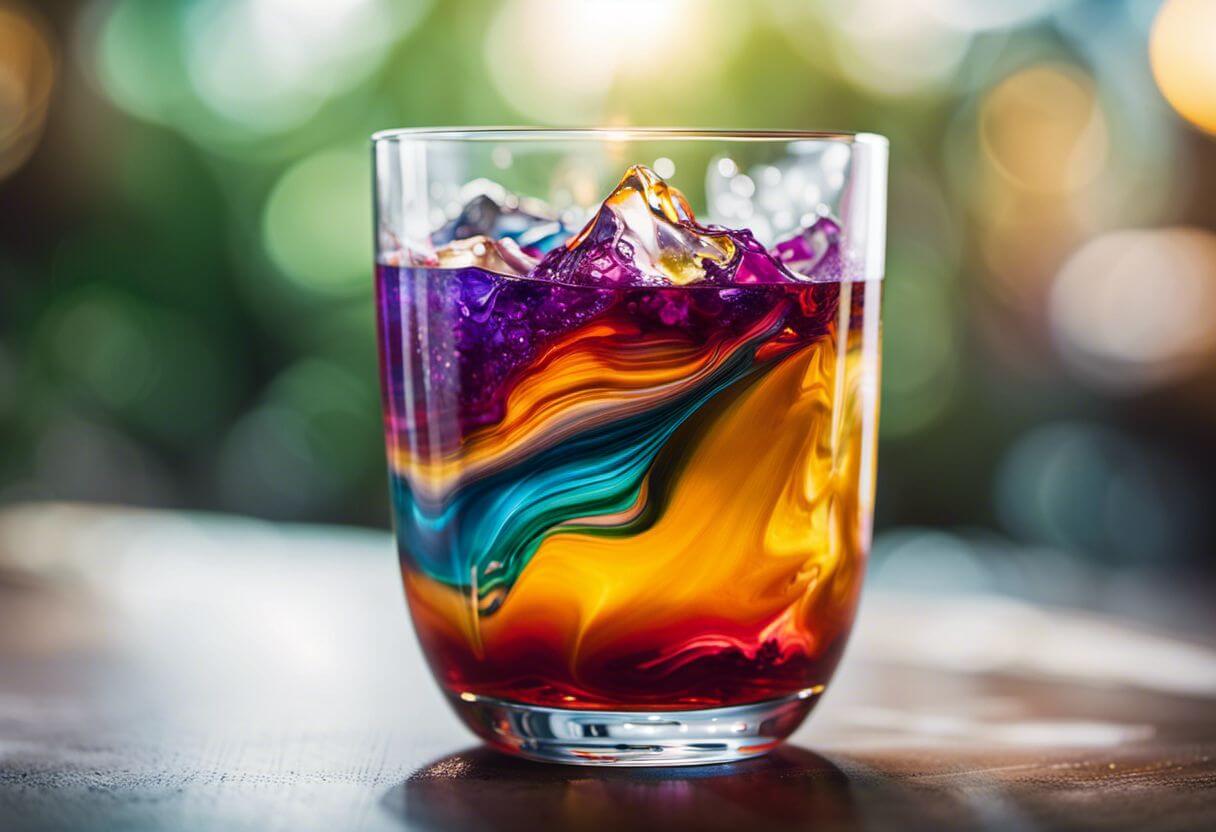Do you enjoy using MiO to flavor your water but are concerned about its health effects? You’re in good company. I also liked adding this zesty flavor to my water until I discovered it contains artificial flavors and potential health hazards.
Below are nine harmful ingredients found in MiO products and their impact on your health.

1. Acesulfame Potassium
Acesulfame potassium is an artificial sweetener that is widely used in foods and beverages, including MiO. While it has been approved as a food additive and is considered safe for human consumption by regulatory authorities, some studies have raised concerns about its potential side effects.
A study published in the journal Stroke in 2017 analyzed health data from nearly 3,000 adults and found that artificial sweeteners in diet beverages, including AceK, increase the risk of dementia and stroke.
Another study done by Mol Nutr Food Res in 2022 found that long-term high-dose exposure to acesulfame potassium can induce uterine hypercontraction, increase cytokine secretion, and alter contraction-related protein expression. It may increase the risk of preterm delivery.
A 2022 study documented by Food and Health found that acesulfame potassium showed a cytotoxic effect in human hepatocellular carcinoma (HepG2) cell line and human lymphocytes at higher concentrations. It also exhibited a mild genotoxic effect by increasing the frequency of chromosomal aberrations (CAs) at long-term treatment and DNA damaging effect only at 15 μg/mL.
2. Sucralose
Sucralose is an artificial sweetener in MiO that is approved by the FDA for use in foods and drinks. While it is low in calories and highly sweet, there are concerns about its potential side effects on human health.
According to a computational study published by FARMACIA in 2021, sucralose has been associated with nephrotoxicity, mutagenicity, and genotoxic carcinogenicity.
A study published by Gut Microbes in 2020 points out that sucralose consumption during pregnancy and lactation may have long-term effects on gut health.
Some studies have shown that sucralose consumption has no significant effect on blood glucose, insulin, or gut hormone concentrations, while others have reported mixed results (Nutrition Reviews, 2020).
For more information about how MiO affects blood sugar levels, check out my “Does MiO Break A Fast?” article.

3. Propylene Glycol
Propylene glycol is a substance commonly used as a food preservative, which is present in MiO water enhancer. The US and European food authorities have declared it as generally safe for use in foods. However, there are some potential side effects associated with the consumption of propylene glycol:
- Skin irritation and allergic reactions;
- Mild skin irritation, including causing dermatitis and a rash on the face or the whole body;
- CNS toxicity, hyperosmolarity, hemolysis, cardiac arrhythmia, and lactic acidosis, especially in children (J Pediatr Pharmacol Ther, 2014).
4. Potassium Sorbate
Potassium sorbate is a synthetically produced preservative that is used in a wide range of foods, including MiO water enhancers. According to the FDA and the Center for Science in the Public Interest, potassium sorbate is generally recognized as safe to consume.
Studies have shown that potassium sorbate can potentially trigger an allergic reaction, although these reactions are rare
Despite purity requirements for manufacturers, it’s possible that potassium sorbate as a food additive can be contaminated with lead, arsenic, or mercury, according to Healthline.
Some studies also linked potassium sorbate to cellular DNA damage, migraines, and an elevation of potassium in the bloodstream.
5. Yellow 5
Yellow 5, also known as tartrazine, is an artificial food coloring. It has numerous negative side effects, although the FDA claims it is safe for consumption. The following are the most common side effects of consuming Yellow 5:
- Allergies
- Migraines
- Hyperactivity
- Hives
- Itching
Some studies have also suggested that Yellow 5 may cause skin irritation and sensitivity, worsen eczema symptoms, and cause acute urticaria (skin rash), as reported by WebMD.
Additionally, Yellow 5 has been linked to behavioral changes in children, including loss of concentration and impulsive, hard-to-control activity.
Research has shown that Yellow 5 may harm cells over time, especially when cells are exposed to high concentrations of the dye. This may make tumor growth and diseases like cancer more likely, according to Healthline.
6. Red 40
Red dye 40 is a food coloring made from petroleum that is approved by the U.S. Food and Drug Administration (FDA) for use in foods and drinks.
While most people will not experience any side effects or health complications from consuming Red Dye 40, some studies have linked it to hyperactivity, including ADHD, in children, according to Cleveland Clinic.
Other potential side effects of consuming Red Dye 40 may include behavioral changes like irritability and depression, allergic reactions, hives and asthma, sneezing, watery eyes, skin irritation, and migraines. Red dye 40 also contains benzene, a known cancer-causing substance.
Some people are allergic to certain synthetic dyes, and in these cases, coming into contact with Red Dye 40 may cause an allergic reaction, as reported by Healthline.
Additionally, both adults and children have reported upset stomach, migraines, jitteriness, nervousness, and inability to concentrate after a high intake of Red Dye 40.
7. Caffeine
Caffeine, found in MiO Energy, can have various side effects when consumed in excessive amounts. Here are some common side effects of consuming too much caffeine:
- Restlessness and shakiness
- Insomnia
- Headaches
- Dizziness
- Fast heart rate
- Dehydration
- Anxiety
- Dependency, leading to the need for higher doses to achieve the same effects
In addition to these side effects, cutting back on caffeine abruptly after regular consumption can cause withdrawal symptoms such as headaches, drowsiness, irritability, nausea, and trouble concentrating, according to MedlinePlus.
Each serving of MiO Energy contains 60 mg of caffeine, which is about the same amount as a cup of coffee. The FDA recommends keeping your daily caffeine intake below 400 mg to avoid potential risks.
8. Citric Acid
Citric acid is used as a preservative in MiO products, and is generally recognized safe for consumption by the FDA. However, there are some potential side effects and risks associated with citric acid, according to WebMD:
- Tooth problems: Drinks and candies that contain citric acid can wear away the enamel (the outer layer) of your teeth
- Skin irritation: Citric acid can cause skin irritation and make certain skin conditions worse. It is important to use products containing citric acid cautiously, especially if you have sensitive skin
- Skin burns: Using products with higher concentrations of citric acid or using them inappropriately can cause skin burns. Higher concentrations should only be used under the care of a dermatologist
- Allergic reactions: Some individuals may experience allergic reactions to citric acid, although these reactions are rare. Symptoms may include skin rash, itching, hives, and swelling of the face.
9. B Vitamins
MiO Vitamins contains vitamins B3, B6, and B12, excessive intake of which can lead to various side effects, according to Healthline:
- Vitamin B6: Too much B6 may lead to peripheral neuropathy, which is a loss of feeling in the arms and legs.
- Vitamin B12: An overdose of vitamin B12 is rare, but it can cause complications like headache, upset stomach, weakness, and nervousness.
- Vitamin B3: An overdose of this vitamin can cause complications like blurry vision, nausea and vomiting, abdominal pain and bloating, headache, and nervousness.
Are There Healthy MiO Alternatives?
Yes, there are alternative options available in the market that do not contain harmful ingredients typically found in MiO. These alternatives use natural sweeteners like stevia or monk fruit extract and avoid synthetic colorings and preservatives.
